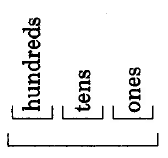1.7: Summary of Key Concepts
- Page ID
- 49578
Summary of Key Concepts
Number / Numeral
A number is a concept. It exists only in the mind. A numeral is a symbol that represents a number. It is customary not to distinguish between the two (but we should remain aware of the difference).
Hindu-Arabic Numeration System
In our society, we use the Hindu-Arabic numeration system. It was invented by the Hindus shortly before the third century and popularized by the Arabs about a thousand years later.
Digits
The numbers 0, 1, 2, 3, 4, 5, 6, 7, 8, 9 are called digits.
Base Ten Positional System
The Hindu-Arabic numeration system is a positional number system with base ten. Each position has value that is ten times the value of the position to its right.

Commas / Periods
Commas are used to separate digits into groups of three. Each group of three is called a period. Each period has a name. From right to left, they are ones, thousands, millions, billions, etc.
Whole Numbers
A whole number is any number that is formed using only the digits (0, 1, 2, 3, 4, 5, 6, 7, 8, 9).
Number Line
The number line allows us to visually display the whole numbers.
Graphing
Graphing a whole number is a term used for visually displaying the whole number. The graph of 4 appears below.

Reading Whole Numbers
To express a whole number as a verbal phrase:
- Begin at the right and, working right to left, separate the number into distinct periods by inserting commas every three digits.
- Begin at the left, and read each period individually.
Writing Whole Numbers
To rename a number that is expressed in words to a number expressed in digits:
- Notice that a number expressed as a verbal phrase will have its periods set off by commas.
- Start at the beginning of the sentence, and write each period of numbers individually.
- Use commas to separate periods, and combine the periods to form one number.
Rounding
Rounding is the process of approximating the number of a group of objects by mentally "seeing" the collection as occurring in groups of tens, hundreds, thousands, etc.
Addition
Addition is the process of combining two or more objects (real or intuitive) to form a new, third object, the total, or sum.
Addends / Sum
In addition, the numbers being added are called addends and the result, or total, the sum.
Subtraction
Subtraction is the process of determining the remainder when part of the total is removed.
Minuend / Subtrahend Difference

Commutative Property of Addition
If two whole numbers are added in either of two orders, the sum will not change.
3 + 5 = 5 + 3
Associative Property of Addition
If three whole numbers are to be added, the sum will be the same if the first two are added and that sum is then added to the third, or if the second two are added and the first is added to that sum.
(3 + 5) + 2 = 3 + (5 + 2)
Parentheses in Addition
Parentheses in addition indicate which numbers are to be added first.
Additive Identity
The whole number 0 is called the additive identity since, when it is added to any particular whole number, the sum is identical to that whole number.
0 + 7 = 7
7 + 0 = 7


